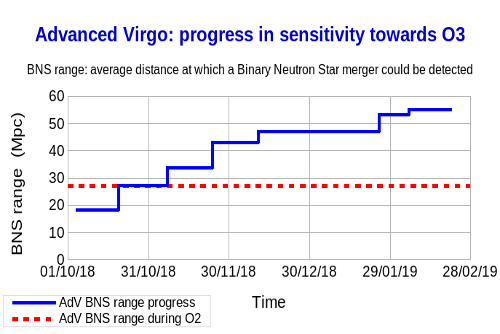Gravitational Waves: astrophysics, source modeling, data analysis, construction of the Virgo detector
The world’s three principal gravitational-wave detectors - LIGO in the US, VIRGO in Italy, and now KAGRA in Japan - have today, the 4th of October, 2019, signed a memorandum of agreement (MoA) that covers scientific collaboration. The agreement includes the joint observation of gravitational waves and the sharing of data over the coming years, while it also foresees the expansion of the collaboration through the welcoming of new partners in the future.
Today March 4th, 2019 the Advanced LIGO and Advanced Virgo detectors are starting their 14th Engineering Run. ER14 will last at least four weeks: it will be the final test before the start of the 3rd LIGO-Virgo Observation Run (O3). During the first half of the run activities will be scheduled that might still improve the three interferometres in the network. ER14 will allow scientists to perform long-term tests of the detector stability, as well as to check the readiness of the software that analyses data in real time.
The LIGO and Virgo Collaborations present new results from searches for coalescing cosmic objects. The LIGO and/or Virgo interferometers have now confidently detected gravitational waves from a total of 10 stellar-mass binary black hole mergers and one merger of neutron stars, which are the dense, spherical remains of stellar explosions. Seven of these events had been reported before, while four of the black hole detections are newly announced.
From September 12, 2015, to January 19, 2016, during the first LIGO observing run since undergoing upgrades in a program called Advanced LIGO, gravitational waves from three binary black hole mergers were detected.
Discovery marks first cosmic event observed in both gravitational waves and light.
For the first time, scientists have directly detected gravitational waves — ripples in space and time — in addition to light from the spectacular collision of two neutron stars. This marks the first time that a cosmic event has been viewed in both gravitational waves and light.
The discovery was made using the U.S.-based Laser Interferometer Gravitational-Wave Observatory (LIGO); the Europe-based Virgo detector; and some 70 ground- and space-based observatories.
The Virgo collaboration warmly congratulates Rainer Weiss, Barry C. Barish and Kip S. Thorne on the award of the 2017 Nobel prize in physics ‘‘for decisive contributions to the LIGO detector and the observation of gravitational waves’’. The first detection of gravitational waves was announced by the LIGO Scientific Collaboration and the Virgo Collaboration on February 11 2016, five months after the observation of the GW150914 signal, generated by the coalescence of two stellar mass black holes located more than a billion light-years away.
The Virgo collaboration and the LIGO Scientific Collaboration report the three-detector observation of gravitational waves. This result highlights the scientific potential of a global network of gravitational wave detectors, by delivering a better localization of the source and historically first time when the polarizations of gravitational waves have been assessed.The three-detector observation was made on August 14, 2017 at 10:30:43 UTC. The detected gravitational waves were emitted during the final moments of the merger of two black holes with masses about 31 and 25 times the mass of the Sun and located about 1.






